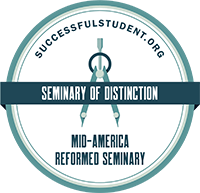The following has been adapted from our "Foundation for the Future" capital campaign newsletter.
Dr. Cornelis Venema
Seminaries, like churches, go through various stages throughout their history. In the early years, there are many challenges. These include defining your mission and purpose and persuading a supporting constituency to get behind your endeavor. When I first arrived at Mid-America Reformed Seminary in 1988, the school was in Orange City, Iowa. In a period of “new beginnings,” the Seminary was like a newly planted seedling that needed careful cultivation to maintain itself and eventually flourish. Nestled among growing fields of soybeans and corn, Mid-America was in a circumstance like that of its neighboring farmer’s newly planted crop. The seeds were sown, but they needed favorable weather and cultivation if they were to grow and bear much fruit.
After thirteen years of labor in Northwest Iowa, the Board of Trustees made a difficult decision to relocate the Seminary to Dyer, Indiana, in the south suburbs of Chicago. The decision was especially difficult because the school enjoyed the warm, generous support of many loyal constituents in Northwest Iowa, who had welcomed the Seminary’s birth and nurtured it through the early years. However, the Board’s decision to move to the Chicago area was motivated by a desire to see the school serve a greater number of confessionally Reformed and Presbyterian churches, many of which were located in the south suburbs of Chicago, Western Michigan, the province of Ontario, Canada to the Northeast, and elsewhere. The new location of the Seminary was chosen because it lies in what is often described as the “crossroads” of North America.
Though the Seminary relocated in 1995, its original vision remained the same: to provide an academically rigorous and pastorally focused preparation of students for the ministry of the Word and sacraments in confessionally Reformed and Presbyterian churches. In its new location and facility, the Seminary would have enhanced opportunities to serve more churches with its unique approach to training students who aspire to gospel ministry.
As I reflect upon Mid-America’s history over the twenty-eight years of labor in Dyer, Indiana, I am reminded of words often used by Rev. John Piersma, one of the founders of the Seminary—“Mid-America is a faith venture.” Piersma used this expression to underscore the uncertain prospects of success when the school was first established. What likelihood was there for success and fruitfulness in a day of such “small things?” And yet, as I look back over the years in our present location and facility, I marvel at how the Lord has provided for and blessed us. When we needed new staff or faculty members, He provided them. When we needed financial resources to enable the school to do its work, we enjoyed the favor of many generous donors and churches. Our student population has grown slowly but steadily to the point where our present facility is nearly full. With the addition of new faculty and staff, some of whom are engaged in student recruiting and marketing, we no longer have enough offices to furnish them with a workplace of their own. The Seminary recently launched the Center for Missions and Evangelism under the direction of Dr. Eric Watkins, but the Center has no physical space on campus to serve as a hub for its work.
My brief rehearsal of Mid-America’s history aims to explain why we seek to expand our facility. We are not doing so because we have changed our historic commitment to offering our students a residential program of study to prepare them for pastoral ministry, especially preaching the gospel of Jesus Christ. Nor are we doing so out of a desire to have a larger student body. We do not believe, for example, that our approach to theological education, with its emphasis upon the pastoral mentorship of our students, can be achieved with a student body that exceeds seventy-five students. Instead, we aim to enhance our present facility to accommodate a student body modestly larger than at present (our current facility can accommodate 45 students, but with the expansion, we will be able to accommodate as many as 60-75 students). The development will include a larger classroom, several new offices for staff and faculty members, and a chapel auditorium. Our chapel is a modified classroom, but the proposed chapel-auditorium will serve several purposes, including hosting evening classes and conferences.
As we embark upon this project, we are keenly aware of our constant dependence upon the Lord’s provision and blessing. We recognize that the project’s cost is significant and that we must always be wise stewards of the gifts that the Lord entrusts to us through His people. But we also believe that we must venture in faith, confident that the Lord will continue to provide for our work even as He has throughout the Seminary’s history. Please join us as we lay a foundation for the future that the Lord has in store for Mid-America Reformed Seminary.
To learn more about our capital campaign, click here.

